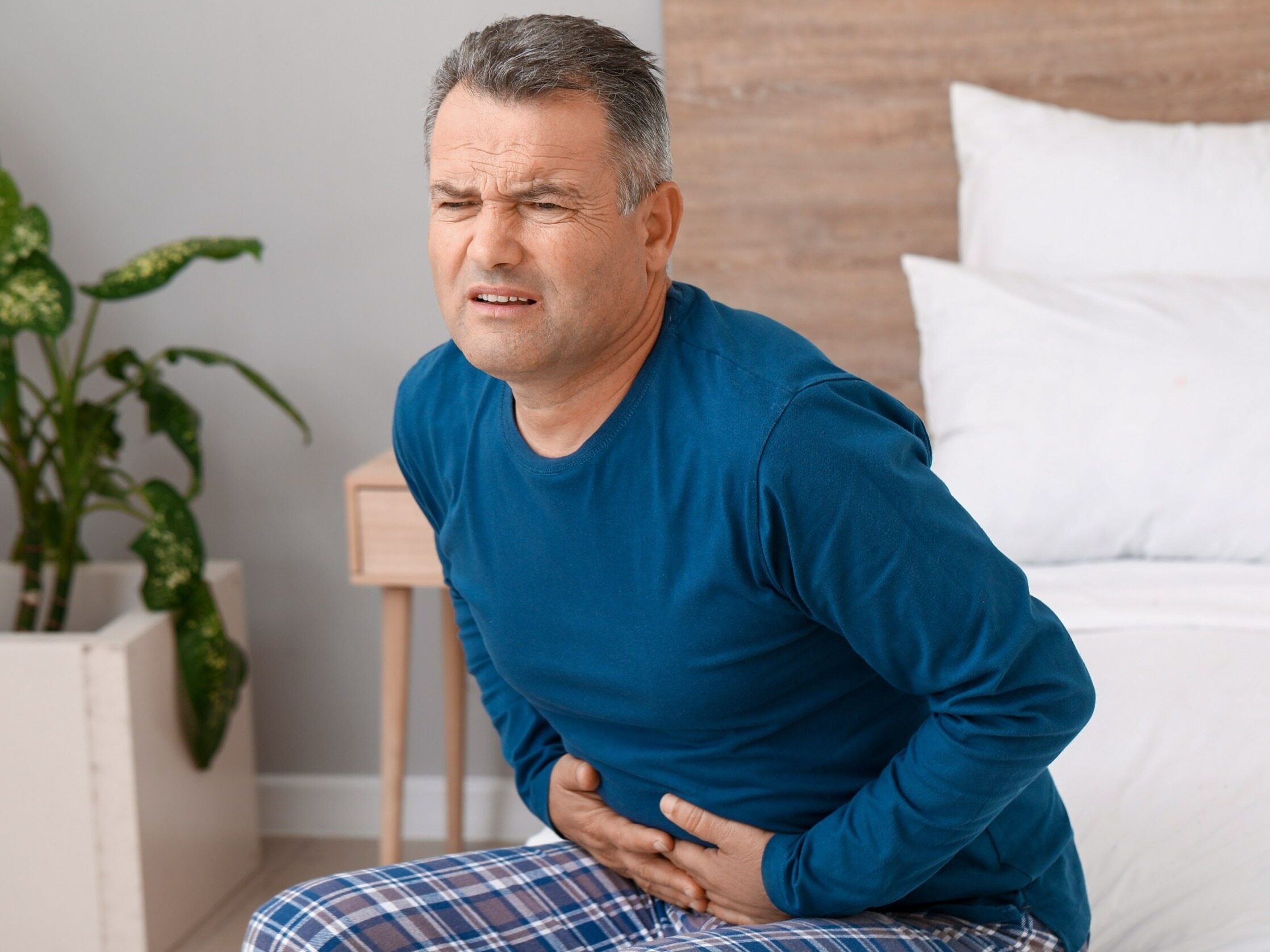Pain in the lower abdomen – the most common causes, accompanying symptoms and ways to get rid of it

Pain in the lower abdomen most often indicates diseases of the lower digestive tract and diseases of the urinary and sexual systems. However, it may also be associated with, for example, diseases of the lumbar spine. What are the most common causes of this condition? When is immediate medical consultation necessary? We explain.
- Pain in the lower abdomen and lifestyle
- Pain in the lower abdomen of physiological origin
- Pain in the lower abdomen and stress
- Pathological causes of lower abdominal pain
- Lower abdominal pain and digestive system diseases
- Lower abdominal pain and diseases of the urinary system and reproductive system organs
- How to treat lower abdominal pain?
Lower abdominal pain, or abdominal pain below the navel line, appears not only in the course of various diseases of the abdominal organs, indicating, for example, inflammation and infections of the urinary tract or digestive system diseases. Pain in the lower abdomen may also have physiological causes. It happens that lower abdominal pain is not related to the abdominal cavity, but, for example, to the lumbar spine. It is worth remembering that both acute lower abdominal pain and low-intensity lower abdominal pain that persistently recurs or occurs chronically should be consulted with a doctor.
Pain in the lower abdomen and lifestyle
Lifestyle may be related to pain in the lower abdomen. Lower abdominal pain occurs in both people who lead a sedentary lifestyle and physically active people.
In the case of a sedentary lifestyle, pain in the lower abdomen may be related to spending many hours in a forced position, which causes pressure on the abdominal organs, which impairs their functioning. Lack of physical activity and spending free time and working in a sitting position are common causes of pain in the lower abdomen. Pain in the lower abdomen is troublesome, among others: people who use an incorrectly selected chair and desk, slouching and putting excessive strain on the lumbar spine.
A sedentary lifestyle also promotes digestive disorders and slower intestinal function. Moreover, lower abdominal pain may be related to an unhealthy diet that promotes flatulence, constipation and other disorders of the lower digestive tract.
In the case of physically active people, e.g. amateur sports people, lower abdominal pain may be caused by excessive strain on the spine and abdominal muscles due to intense exercise. If the abdominal muscles are significantly overstretched, pain in the lower abdomen may indicate diastasis pubis.
Pain in the lower abdomen also bothers people who have decided to change their lifestyle to a more active one – in this case, it is most often related to the inappropriate type of physical activity and its intensity to their physical condition.
Lower abdominal pain, which is related to lifestyle, is not accompanied by other symptoms that indicate inflammation, e.g. increased body temperature, frequent urination, burning sensation during urination, nausea, vomiting and vaginal discharge.
Pain in the lower abdomen of physiological origin
Physiological lower abdominal pain is associated with menstruation, pregnancy or ovulation. Menstrual pain is crampy in nature, but its severity should not impede normal functioning. If the intensity of pain during menstruation makes normal functioning difficult or impossible and other symptoms appear, e.g. nausea, vomiting, dizziness or fainting, you should consult a gynecologist. Both primary dysmenorrhea and secondary dysmenorrhea are indications for tests for, among others: hormonal disorders and diseases of the reproductive organs.
Lower abdominal pain and a feeling of tension in the lower abdomen may also indicate ovulation. Ovulation pain appears halfway through the menstrual cycle. Ovulation is indicated by, for example, a stabbing pain on the left or right side that appears for several months only during ovulation. Sometimes ovulation pain is accompanied by spotting or minor bleeding from the genital tract. Pain during ovulation is related to, among others: with fallopian tube contractions. Bleeding may be caused by a broken blood vessel.
Physiological pain in the lower abdomen is also implantation pain, which may occur when the embryo implants in the uterus. In this case, slight bleeding may occur. Pain in the lower abdomen in the first weeks of pregnancy, although it can cause stress for the future mother, is most often caused by the stretching of the uterus.
Important! If you are pregnant or suspect that you may have been pregnant, you should consult your doctor about any abdominal pain!
Pain in the lower abdomen and stress
Abdominal pain may be caused by excessive nervous tension. The digestive system is sensitive to both chronic stress and sudden stressful stimuli. Stress may be related to, for example, cramping pain in the lower abdomen, accompanied by strong bowel movements and diarrhea, or nausea and vomiting. Lower abdominal pain caused by stress may appear, for example, before important events and situations that cause nervous tension. Recurrent lower abdominal pain that appears in stressful situations should prompt consultation not only with your general practitioner, but also with a psychologist.
Chronic stress may result in irritable bowel syndrome (IBS).
Pathological causes of lower abdominal pain
Common causes of pain in the lower abdomen include diseases of the digestive system and diseases of the urinary system and those developing in the reproductive organs. These diseases cause not only pain in the lower abdomen, but also other ailments.
Disease-related pain in the lower abdomen may vary in intensity and nature. It is not always a sudden, intense pain. Some diseases may cause chronic or recurrent abdominal pain and, for example, flatulence, nausea, constipation, diarrhea and other ailments, including: pain or burning when urinating.
In the case of diseases of the digestive system, reproductive system and urinary system, stabbing abdominal pain, dull abdominal pain or colic pain in the lower abdomen may occur. Pain may be felt in the entire lower abdomen or on the right or left side. Sometimes it is difficult to pinpoint exactly where the stomach hurts. Moreover, pain may radiate, for example, to the lumbar spine, groin or lower limbs.
Lower abdominal pain and digestive system diseases
Pain in the lower abdomen is often one of the first symptoms of digestive system diseases. It appears in the course of diseases in the lower digestive tract. It may be caused by disorders in the functioning of internal organs, inflammation and emergencies that require immediate medical intervention.
One of the causes of pain in the lower abdomen is acute appendicitis. Appendicitis in its early stages may cause abdominal pain around the navel, but over time the pain localizes to the right side, in the iliac fossa. Appendicitis causes gradually increasing pain, which is initially relieved by antispasmodic medications. Over time, the pain intensifies and may be accompanied by, among others: nausea and vomiting. Appendicitis requires surgical treatment.
Lower abdominal pain may also be caused by intestinal inflammation. This symptom may indicate non-specific inflammatory bowel diseases, including Crohn’s disease and ulcerative colitis. Other inflammatory bowel diseases include:
-
inflammation of the small intestine associated with bacterial and viral infections,
-
inflammation of intestinal diverticulitis resulting from dietary mistakes.
Inflammatory bowel diseases cause pain in the middle lower abdomen and lower abdominal pain in the right side and left side.
Other diseases that cause lower abdominal pain include: irritable bowel syndrome and stomach ulcers. Intestinal obstruction is a threat to health and life, and it also causes, among others, severe pain in the lower abdomen. Sometimes lower abdominal pain indicates cancer of the digestive system.
Alarm signals that should prompt you to visit a doctor include: increased body temperature, nausea, vomiting of grounds, constipation, blood in the stool, gas retention and stool retention.
Lower abdominal pain and diseases of the urinary system and reproductive system organs
Urinary tract diseases that cause lower abdominal pain include: cystitis, nephrolithiasis, bladder stones and pyelonephritis. Other disturbing urinary symptoms that may accompany lower abdominal pain include: pain and burning when urinating, oliguria, frequent urination, nausea, vomiting, increased body temperature, change in urine color or odor, as well as hematuria and urinary retention.
All of the above symptoms should cause concern and prompt you to see a doctor.
Lower abdominal pain is also a symptom of diseases of the reproductive system in women and men. In women, lower abdominal pain may be caused by, among others:
-
uterine fibroids,
-
ovarian torsion,
-
ovarian cysts,
-
intimate infections,
-
adnexitis,
-
endometriosis.
Lower abdominal pain in a woman who is of childbearing age and has stopped menstruating may indicate an ectopic pregnancy or miscarriage. In the case of an ectopic pregnancy, lower abdominal pain most often appears on one side of the abdomen. Alarm signals for women that should prompt immediate medical consultation include: vaginal discharge, bleeding or spotting between periods, bleeding after intercourse, pain during intercourse, increased body temperature, changes in the vulva area.
In men, pain in the lower abdomen may indicate, among others: for prostatitis and other prostate diseases, as well as intimate infections. Alarm signals in men that should prompt immediate medical consultation include: discharge from the urethra, frequent urination at night, problems with completely emptying the bladder, changes in the testicles and penis, e.g. swelling, pain during intercourse, as well as blood in semen and painful ejaculation.
How to treat lower abdominal pain?
Treatment of lower abdominal pain depends on its cause. It is important to remember that pain is not a disease, but a symptom of a disease, so the doctor must find out what is the cause of the pain. For this purpose, various tests may be performed, e.g. abdominal ultrasound, gynecological examination, urological examination, blood test and urine test.
In the treatment of lower abdominal pain, pharmaceuticals are used, e.g. antispasmodics and anti-inflammatory drugs, as well as other medicinal preparations whose action is selected according to the diagnosed cause of the ailment. Sometimes surgical treatment is necessary when, for example, appendicitis, ectopic pregnancy or intestinal volvulus are diagnosed.
Sources:
-
Szczeklik A., Internal diseases, Volume I, Medycyna Practical Publishing House, Kraków, 2005
-
Szczeklik A., Internal diseases, Volume II, Medycyna Practical Publishing House, Kraków 2006
-
Dąbrowski A., Wielka Interna Gastroenterologia Volume II, Medical Tribune Polska Publishing House, 2019
-
Kimberly B. Fortner, Linda M. Szymanski, Harold E. Fox, Edward E. Wallach, Textbook of Gynecology and Obstetrics. Hopkins, MediPage Publishing House, 2012






